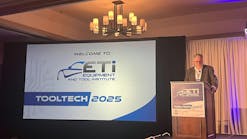Continental announces fifth radar generation
Technology company Continental has introduced the fifth generation of its short- and long-range radar sensors, which incorporate the company's extensive, long-standing expertise in vehicle surroundings sensors, the company said. This new generation will enter series production in 2019 and will feature greater capacity, catering to vehicle manufacturers' different requirements and electrical-electronic (E/E) architectures as it is also based on a scalable modular principle. Thanks to the worldwide trend of using 77 GHz technology, the sensor resolution increases and can detect smaller objects, such as an exhaust pipe that has fallen off, more accurately. With long-range radar, a range of up to 900' and an opening angle of +/- 60 degrees are possible in the highest expansion stage depending on the required performance. With short-range radar, precise parking functions can be executed easily for the first time, in addition to functions such as blind spot detection, lane change assist or rear cross traffic alert, according to the company.
"With the fifth generation of our powerful and tried-and-tested radar sensors, we are opening up new opportunities for modern advanced driver assistance systems," said Amit Kapoor, Head of Advanced Driver Assistance Systems at Continental North America. "Our latest radar generation is an important element in our technology portfolio to further strengthen and advance our leading position in the development of assisted and automated driving. In particular, the elevation measuring capability of our radar sensors allows the most varied of objects, even relatively small objects, to be detected more precisely."
Flexible usage and suitable for future E/E architectures
Continental's radar sensors are based on a highly sophisticated radar technology that benefits from four generations and almost 30 million units in series deployment to date. Measured against the scope of its performance, the development leap of the new generation lies in its compactness and flexible usage, the company said.
The image of the surroundings produced by the radar is sent to a central control unit such as the Assisted & Automated Driving Control Unit. In this way, different E/E architectures of vehicles can be covered using a single sensor concept. In addition to today's standards for bus systems, such as High-Speed CAN and CAN-FD, the fifth generation is already prepared for Automotive Ethernet, thanks to the hardware concept, which ensures that the necessary bandwidth for transmitting sensor raw data to the Assisted & Automated Driving Control Unit is available.
Enhanced performance thanks to higher resolution and more precise detection
One of the features of the new generation is a higher resolution compared to previous radar generations, enabling a more exact snapshot of the current traffic situation. In addition, road boundaries like curbstones as well as the height of objects, such as the end of a traffic jam under a bridge are detected thanks to the sensors' evaluation measurement accuracy. Even the entry-level variant of the long-range radar has a range of 600' and an opening angle of +/- 45 degrees. The expansion stage currently in preparation will look 900' ahead, with an opening angle of +/- 60.
When four of the short-range radar sensors are installed on the corners of a vehicle, the wider opening angle and higher resolution facilitate a seamless 360 degree radar "safety belt" all the way around the vehicle. Such a detailed and seamless display of the entire area surrounding the vehicle is important, since the vehicle would not be able to take on the driver's tasks in automated driving otherwise, according to the company. In conjunction with other sensors, such as a camera, surround view systems and 3D Flash LiDAR, the goal of achieving an understanding of the vehicle surrounding that is equal to or even better than that of a human being is coming closer.
In order to meet the rising demand worldwide, Continental is constantly expanding its production capacities. Production of long-range radar sensors was launched in Shanghai, China, in October of this year with the goal of producing several million units a year in order to meet the local high demand. The sensors are also produced in Germany, the U.S. and the Philippines.


